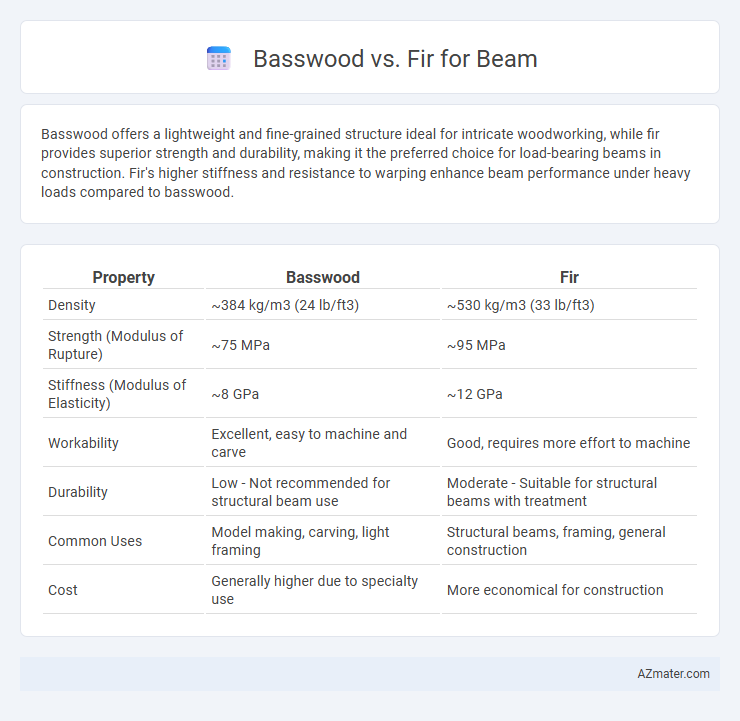Basswood offers a lightweight and fine-grained structure ideal for intricate woodworking, while fir provides superior strength and durability, making it the preferred choice for load-bearing beams in construction. Fir's higher stiffness and resistance to warping enhance beam performance under heavy loads compared to basswood.
Table of Comparison
| Property | Basswood | Fir |
|---|---|---|
| Density | ~384 kg/m3 (24 lb/ft3) | ~530 kg/m3 (33 lb/ft3) |
| Strength (Modulus of Rupture) | ~75 MPa | ~95 MPa |
| Stiffness (Modulus of Elasticity) | ~8 GPa | ~12 GPa |
| Workability | Excellent, easy to machine and carve | Good, requires more effort to machine |
| Durability | Low - Not recommended for structural beam use | Moderate - Suitable for structural beams with treatment |
| Common Uses | Model making, carving, light framing | Structural beams, framing, general construction |
| Cost | Generally higher due to specialty use | More economical for construction |
Introduction to Basswood and Fir as Beam Materials
Basswood beams offer a lightweight, fine-grained alternative with excellent workability and smooth finish, ideal for detailed woodworking and moderate structural applications. Fir beams, particularly Douglas Fir, provide superior strength, durability, and resistance to warping, making them a preferred choice for heavy-load structural frameworks. Both species balance performance and aesthetics but differ significantly in load-bearing capacity and moisture resistance, influencing their selection in construction projects.
Physical Properties: Basswood vs Fir
Basswood is a lightweight, softwood with a low density of about 12-15 lbs/ft3, offering moderate strength and excellent workability, making it ideal for precision carving and indoor beams with minimal load requirements. Fir, specifically Douglas Fir, has a higher density ranging from 28-33 lbs/ft3, providing superior strength, stiffness, and load-bearing capacity, which is essential for structural beams in construction. The physical durability of Fir, combined with its natural resistance to deformation under heavy loads, contrasts with Basswood's softness and lower mechanical strength, dictating their suitability in beam applications.
Strength and Durability Comparison
Basswood offers moderate strength and is lightweight, making it less suitable for heavy structural beams compared to fir, which boasts higher strength and load-bearing capacity. Fir is renowned for its excellent durability, resistance to wear, and ability to withstand environmental stress, often used in construction for its long-lasting performance. Basswood's softness and lower density result in limited durability under heavy loads, while fir provides superior structural integrity in beam applications.
Weight and Density Considerations
Basswood exhibits a lower density, approximately 0.32-0.40 g/cm3, resulting in a lighter beam ideal for applications requiring reduced weight without compromising structural integrity. Fir, with a higher density around 0.45-0.50 g/cm3, offers greater strength and load-bearing capacity but increases the overall weight of the beam. Choosing between basswood and fir for beams depends on balancing weight constraints with the necessary density to withstand expected loads.
Workability and Ease of Use
Basswood offers superior workability compared to fir due to its soft texture, making it easier to cut, shape, and sand for beam applications. Fir, while stronger, is denser and can be more challenging to work with, often requiring sharper tools and more effort. Both woods are commonly used in construction, but basswood's ease of use makes it preferred for detailed craftsmanship, whereas fir is favored for structural strength.
Cost and Availability
Basswood beams tend to be more expensive due to their limited availability and slower growth rate compared to fir, which is widely cultivated and more abundant. Fir offers a cost-effective option for beams, often preferred in construction projects for its consistent supply and affordability. Availability of fir in various grades ensures easier procurement, while basswood's scarcity can significantly increase lead times and overall project expenses.
Aesthetic Differences for Exposed Beams
Basswood beams exhibit a fine, uniform grain with a pale, creamy color that enhances minimalist and modern aesthetics in exposed beam applications. Fir beams present a more pronounced grain pattern with warm, reddish-brown tones, lending a rustic and natural appearance ideal for traditional or cabin-style interiors. The choice between basswood and fir largely depends on the desired visual effect, with basswood offering subtle elegance and fir providing bold character.
Environmental Impact and Sustainability
Basswood beams offer a lower environmental impact due to their faster growth rate and sustainable harvesting practices, resulting in reduced carbon footprint compared to fir. Fir beams, while strong and durable, typically come from slower-growing trees requiring longer cultivation periods, which may contribute to deforestation and habitat disruption. Choosing basswood supports sustainable forestry and carbon sequestration efforts, making it a preferable option for eco-conscious construction projects.
Common Applications in Construction
Basswood beams are commonly used in interior construction, particularly for decorative and lightweight structural elements due to their fine grain and easy workability. Fir beams, favored in heavy timber framing and outdoor applications, offer superior strength and durability, making them ideal for load-bearing frameworks and exterior support structures. The choice between basswood and fir beams hinges on factors like load requirements and environmental exposure, with fir providing enhanced resilience for structural integrity.
Final Recommendations: Choosing Between Basswood and Fir
Fir beams offer superior strength and durability, making them ideal for structural applications requiring high load-bearing capacity and resistance to warping. Basswood, while lighter and easier to work with, suits decorative or non-load-bearing uses due to its softer texture and lower strength. For long-lasting, reliable beam performance, fir is the preferred choice, whereas basswood fits projects prioritizing workability and aesthetic appeal.

Infographic: Basswood vs Fir for Beam
 azmater.com
azmater.com